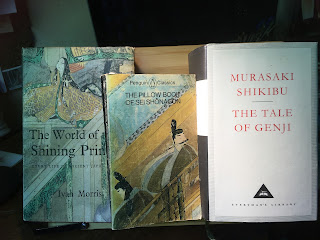It began when I discovered The Pillow Book by Sei Shōnagon written over a thousand years ago.She was a witty, caustic lady-in-waiting at the Imperial court of Heian-Kyo, modern day Kyoto in Japan and her book is a sort of commonplace book containing poems, lists and descriptions of Heian life. This pointed me towards the vast Tale of Genji by Murasaki Shikibu, the first novel written by a woman. Murasaki also served at the same court and the two were rivals. Murasaki's novel, most of which concerns the loves of Prince Genji, also gives a viviid picture of aristocratic life but in a long, rambling story. Ivan Morris's meticulously researched non-fiction volume The World of the Shining Prince then provided me with a very full and readable explanation of this strange, rigid but colourful world so different from anything we know today. A society in which women blackened their teeth in the name of beauty, wore robes of so many layers that they could not walk and communicated by daily exchange of poems - poetry was their social medium.
It wasn't surprising then that when given a travel writing assignment in Kyoto, I should set off in search of traces of Heian life, It must be said very little of it remains. Of the huge old Imperial Palace only Shinsen-en, a tiny scrap of garden is left. Nevertheless armed with a bus pass and map I set off determined to find it.
It was already early evening when I got there and as I was hungry I was delighted to fins a restaurant on the site. It was completely empty but two kimono-clad girls ushered me, bowing deeply, into a dark, rather mysterious room and when they understood that I wanted a meal, they brought a gas burner, a vast post of broth and little dishes containing fish, dumplings, asparagus and other unfamiliar vegetables. All these they cooked in the broth and served to me. It was a most delicious meal and afterwards I took a walk around the garden, There was a little boat moored at the side of a pond which was spanned by a vermillion bridge. There was no one else about and as I looked up at the rising moon I thought how Heian ladies had enjoyed their moon-watching parties here a thousand years ago, gazing at the same moon.
Later on this trip I visited a house, Ninjō-Jinya which although from a later date had the atmosphere of the shoguns and their ninja spies. It was here I first experienced a nightingale floor although I had read about them in Heian literature. A nightingale floor is one specially constructed to squeak when walked on and so warn the inhabitants of intruders. In Ninjō-Jinya there were also secret passageways, false walls, trapdoors, concealed rope ladders, disguised staircases, dead ends and other devices for escape.
It was much later that I came across the book Across the Nightingale Floor by Lian Hearn. Intrigued by the title I bought it and so embarked on a delightful reading spree of the whole series of The Tales of the Otori. Set in medieval Japan this series first marketed as y/a but later unclassified, is about love and magic but does not flinch from the brutality of medieval society. It follows the story of Takeo and Kaede, first as young lovers and later with their children as they struggle to rule their lands peacefully in a world replete with feuds, murder, spies and intrigue. The ruthlessness is somewhat balanced by the compassion and spirituality found in the shrines and monasteries where the protagonists seek peace and solace- but even so there is an awful lot of killing.
The main characters are convincingly human, they have faults and make mistakes but they gain our sympathy. My one caveat is that I became confused by the enormous cast of unfamiliarly-named lesser characters, my own fault really as each book has family trees and descriptions.
Hearn has been criticised for being a Westerner who writes about a foreign culture and various trifling inaccuracies. These critics are missing the point. The books are speculative fiction which, incorporating subtle slivers of magic from time to time, conveys the very atmosphere and otherness of old Japan. Every detail; the birds, the flowers, the gardens, the scents, the sounds, the clothing, the lavish interiors, the swords, the calligraphy and even the horses, seems utterly right. If this is not enough for some critics it is for me and the thousands of readers in 36 countries who delight in Lian Hearn's Japanese world.
It is a great pleasure to escape into this world from time to time.
Patricia Cleveland-Peck www.patriciaclevelandpeck.com




1 comment:
We seem to share similar tastes, Patricia - I've enjoyed The Pillow Book and the Tale of Genji too - and Lian Hearn's books. A fascinating, and so very different world to dip into. But I've not been to Kyoto - I do envy you your travel writing!
Post a Comment